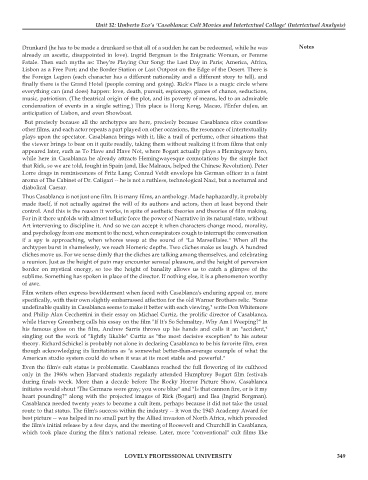Page 355 - DENG501_LITERARY_CRITICISM_AND_THEORIES
P. 355
Unit 32: Umberto Eco’s ‘Casablanca: Cult Movies and Intertextual Collage’ (Intertextual Analysis)
Drunkard (he has to be made a drunkard so that all of a sudden he can be redeemed, while he was Notes
already an ascetic, disappointed in love). Ingrid Bergman is the Enigmatic Woman, or Femme
Fatale. Then such myths as: They're Playing Our Song; the Last Day in Paris; America, Africa,
Lisbon as a Free Port; and the Border Station or Last Outpost on the Edge of the Desert. There is
the Foreign Legion (each character has a different nationality and a different story to tell), and
finally there is the Grand Hotel (people coming and going). Rick's Place is a magic circle where
everything can (and does) happen: love, death, pursuit, espionage, games of chance, seductions,
music, patriotism. (The theatrical origin of the plot, and its poverty of means, led to an admirable
condensation of events in a single setting.) This place is Hong Kong, Macao, I'Enfer duJeu, an
anticipation of Lisbon, and even Showboat.
But precisely because all the archetypes are here, precisely because Casablanca cites countless
other films, and each actor repeats a part played on other occasions, the resonance of intertextuality
plays upon the spectator. Casablanca brings with it, like a trail of perfume, other situations that
the viewer brings to bear on it quite readily, taking them without realizing it from films that only
appeared later, such as To Have and Have Not, where Bogart actually plays a Hemingway hero,
while here in Casablanca he already attracts Hemingwayesque connotations by the simple fact
that Rick, so we are told, fought in Spain (and, like Malraux, helped the Chinese Revolution). Peter
Lorre drags in reminiscences of Fritz Lang; Conrad Veidt envelops his German officer in a faint
aroma of The Cabinet of Dr. Caligari -- he is not a ruthless, technological Nazi, but a nocturnal and
diabolical Caesar.
Thus Casablanca is not just one film. It is many films, an anthology. Made haphazardly, it probably
made itself, if not actually against the will of its authors and actors, then at least beyond their
control. And this is the reason it works, in spite of aesthetic theories and theories of film making.
For in it there unfolds with almost telluric force the power of Narrative in its natural state, without
Art intervening to discipline it. And so we can accept it when characters change mood, morality,
and psychology from one moment to the next, when conspirators cough to interrupt the conversation
if a spy is approaching, when whores weep at the sound of "La Marseillaise." When all the
archtypes burst in shamelessly, we reach Homeric depths. Two cliches make us laugh. A hundred
cliches move us. For we sense dimly that the cliches are talking among themselves, and celebrating
a reunion. Just as the height of pain may encounter sensual pleasure, and the height of perversion
border on mystical energy, so too the height of banality allows us to catch a glimpse of the
sublime. Something has spoken in place of the director. If nothing else, it is a phenomenon worthy
of awe.
Film writers often express bewilderment when faced with Casablanca's enduring appeal or, more
specifically, with their own slightly embarrassed affection for the old Warner Brothers relic. "Some
undefinable quality in Casablanca seems to make it better with each viewing," write Don Whitemore
and Philip Alan Cecchettini in their essay on Michael Curtiz, the prolific director of Casablanca,
while Harvey Greenberg calls his essay on the film "If It's So Schmaltzy, Why Am I Weeping?" In
his famous gloss on the film, Andrew Sarris throws up his hands and calls it an "accident,"
singling out the work of "lightly likable" Curtiz as "the most decisive exception" to his auteur
theory. Richard Schickel is probably not alone in declaring Casablanca to be his favorite film, even
though acknowledging its limitations as "a somewhat better-than-average example of what the
American studio system could do when it was at its most stable and powerful."
Even the film's cult status is problematic. Casablanca reached the full flowering of its culthood
only in the 1960s when Harvard students regularly attended Humphrey Bogart film festivals
during finals week. More than a decade before The Rocky Horror Picture Show, Casablanca
initiates would shout "The Germans wore gray; you wore blue" and "Is that cannon fire, or is it my
heart pounding?" along with the projected images of Rick (Bogart) and Ilsa (Ingrid Bergman).
Casablanca needed twenty years to become a cult item, perhaps because it did not take the usual
route to that status. The film's success within the industry -- it won the 1943 Academy Award for
best picture -- was helped in no small part by the Allied invasion of North Africa, which preceded
the film's initial release by a few days, and the meeting of Roosevelt and Churchill in Casablanca,
which took place during the film's national release. Later, more "conventional" cult films like
LOVELY PROFESSIONAL UNIVERSITY 349

